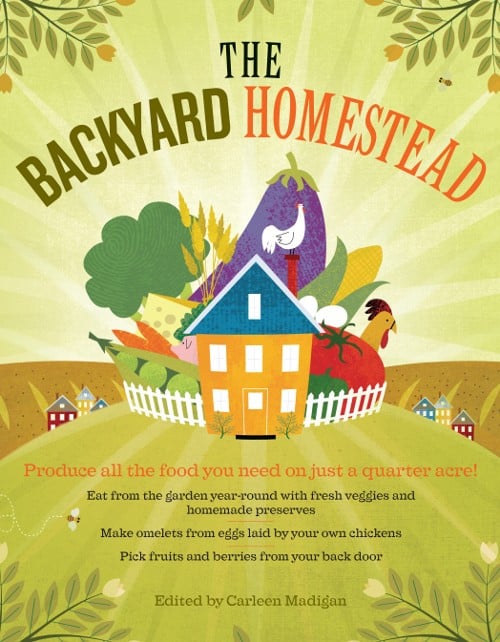I just picked up The Backyard Homestead again. While I see it almost every day, there are years I haven’t touched it. When I do pick it up, I always think, “Why didn’t I look at this sooner?!” It’s so inspirational.
I’m well-versed in gardening and raising chickens. I’m also getting better at making due with less and trying to get back to the basics. When I pick this book up though, I’m always inspired to learn something new to put into practice. It’s motivating and yet peaceful to read (if that makes sense; I don’t feel anxious reading it) and laid out in an easy-to-read format.
The info in this book is timeless. I’m here updating this post in 2023, and find it as helpful as when I first bought it in 2009 or 2010.
A lot of the time, when people are beginning with their homestead, it’s difficult to know which direction to go in.
One thing that’s usually pretty helpful is if you can get one good book that covers a variety of subjects in enough depth for you to give it an experimental try.
The Backyard Homestead, edited by Carleen Madigan, is one of those books. But not only is it a book, but it is also a guide that helps you plan actionable steps. Want to know how?
From a quarter of an acre, a backyard homestead can harvest
- 1,400 eggs
- 50 pounds of wheat
- 60 pounds of fruit
- 2,000 pounds of vegetables
- 280 pounds of pork
- 75 pounds of nuts
For sure, having a bit of land certainly helps with outdoor pursuits. You will have more opportunities for growing food and raising food. However, there is also a lot you can do with limited space or with HOAs and city/town ordinances that may restrict you from, say, raising chickens.

The “Foot-in-the-Door” to Homesteading
The Backyard Homestead covers a myriad of topics including an A-Z veggie guide, basic fruit growing, grains, nuts, herbs, poultry for meat and eggs, livestock for meat and dairy, beekeeping, homebrewing, and more.
Particularly helpful is the way the book is laid out. Each section has the information you need. Even more helpful are all the charts, diagrams, calculations, comparisons, and pretty much anything else you need to get started.
Practical Help You Can Put Into Action
For example, a common question when people are looking to start gardening on a serious food-production level (as opposed to recreational) is how much do I grow?
That question is not an easy one to answer, but they have a good list of veggies, and how much space to allot per person you are growing for.
Not only does it teach you how to produce these goods, but also what to do with them.
It includes recipes, instructions for preservation, and tons of illustrations that demonstrate how to do things, instead of just using words to describe the process.
Particularly of interest to me was one section with a visual layout of how you could produce quite a bit of food on a quarter acre lot (the above example).
This is particularly encouraging because many people feel like they can’t homestead because they live in the city or that it isn’t worthwhile – but truly, you can really do a lot with a small space.
What Else I Like About It
There is lots of white space with a good-sized font. For me, this helps the new-to-me material to not be as overwhelming. Sometimes when learning new things, small print and lots of words on a page make it seem daunting. That’s not the case with this book.
It’s also available as an ebook. You can see if your library has it in paperback or as an ebook. I find I like holding these types of how-to books in a paper format (like recipe books) but enjoy using my Kindle for novels.
The Backyard Homestead by Carleen Madigan is a Keeper
I will be keeping this book close at hand in the next few years as I continue to expand my homestead and my skills.
The beauty of The Backyard Homestead book is that it contains enough information to get you started and going in the direction you want, but it doesn’t have excessive information that you might not be interested in.
For instance, it has quite a bit of information on getting started with cheese making, including basic hard and soft cheese recipes.
I myself am quite interested in cheese making, but I would probably be overwhelmed if I had 100+ recipes to choose from, especially since I’d mostly be interested in a basic farmhouse cheddar anyway.
All in all, this book is a great investment and has lots of up-to-date information about a good variety of different topics.
If you are looking for a resource that will help get you off to a running start on your homestead, look no further – this is exactly what you need.
